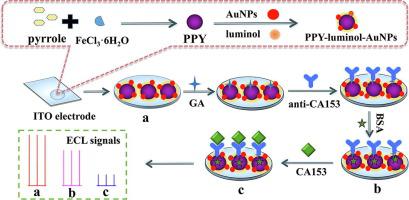Spectrochimica Acta Part A: Molecular and Biomolecular Spectroscopy ( IF 4.4 ) Pub Date : 2021-02-07 , DOI: 10.1016/j.saa.2021.119562 Ying Bao , Kexin Han , Zhifang Ding , Yue Li , Ting Li , Ming Guan , Guixin Li

|
Polypyrrole-luminol-AuNPs nanocomposites were prepared and used to develop a sensitive label-free electrochemiluminescence (ECL) immunosensor for carbohydrate antigen 153 (CA153) detection. Firstly, polypyrrole (PPY) nanoparticles were synthesized by a chemical oxidation method using FeCl3 as an oxidizing agent, then luminol and gold nanoparticles (AuNPs) were combined with PPY nanoparticles through electrostatic interaction to form PPY-luminol-AuNPs nanocomposites. The nanocomposites were characterized by transmission electron microscopy (TEM), UV–Vis absorption spectra, atomic emission spectrometry (AES), X-ray diffraction (XRD) and electrochemical impedance spectroscopy (EIS). Especially, iron element was also detected in the nanocomposites. The PPY-luminol-AuNPs nanocomposites showed excellent ECL activity due to the bi-catalysis of iron ion and gold nanoparticles on the ECL of luminol. Furthermore, the nanocomposites showed good film-forming property, and it can be fixed on electrode surface without the assistance of other film-forming materials. On this basis, an ECL immunosensor for CA153 was constructed by covalently immobilizing anti-CA153 on PPY-luminol-AuNPs modified indium-doped tin oxide (ITO) electrode. In the presence of CA153, a remarkable decrease in ECL signals was observed due to the formation of anti-CA153/CA153 complex. The immunosensor showed a good linear relationship in the concentration range of 0.001 to 700 U/mL for CA153, and the detection limit was 5.8 × 10-4 U/mL (S/N = 3). Furthermore, the ECL immunosensor was applied to the determination of CA153 in practical human serum sample.
中文翻译:

基于双吡咯-鲁米诺-AuNPs纳米复合材料的碳水化合物抗原153的无标记电化学发光免疫传感器
制备了聚吡咯-鲁米诺-AuNPs纳米复合材料,并用于开发灵敏的无标记电化学发光(ECL)免疫传感器,用于检测碳水化合物抗原153(CA153)。首先,使用FeCl 3通过化学氧化法合成了聚吡咯(PPY)纳米颗粒。作为氧化剂,然后通过静电相互作用将鲁米诺和金纳米颗粒(AuNPs)与PPY纳米颗粒结合,形成PPY-鲁米诺-AuNPs纳米复合材料。通过透射电子显微镜(TEM),UV-Vis吸收光谱,原子发射光谱(AES),X射线衍射(XRD)和电化学阻抗谱(EIS)对纳米复合材料进行了表征。特别地,在纳米复合材料中也检测到铁元素。PPY-luminol-AuNPs纳米复合材料由于铁离子和金纳米颗粒在鲁米诺的ECL上的双重催化而显示出优异的ECL活性。此外,纳米复合材料显示出良好的成膜性,并且可以在没有其他成膜材料的帮助下将其固定在电极表面上。在此基础上,通过将抗CA153共价固定在PPY-luminol-AuNPs修饰的铟掺杂氧化锡(ITO)电极上,构建了用于CA153的ECL免疫传感器。在存在CA153的情况下,由于抗CA153 / CA153复合物的形成,观察到ECL信号显着降低。免疫传感器在CA153的浓度范围为0.001至700 U / mL时表现出良好的线性关系,检出限为5.8×10-4 U / mL(S / N = 3)。此外,将ECL免疫传感器用于实际人血清样品中CA153的测定。



























 京公网安备 11010802027423号
京公网安备 11010802027423号